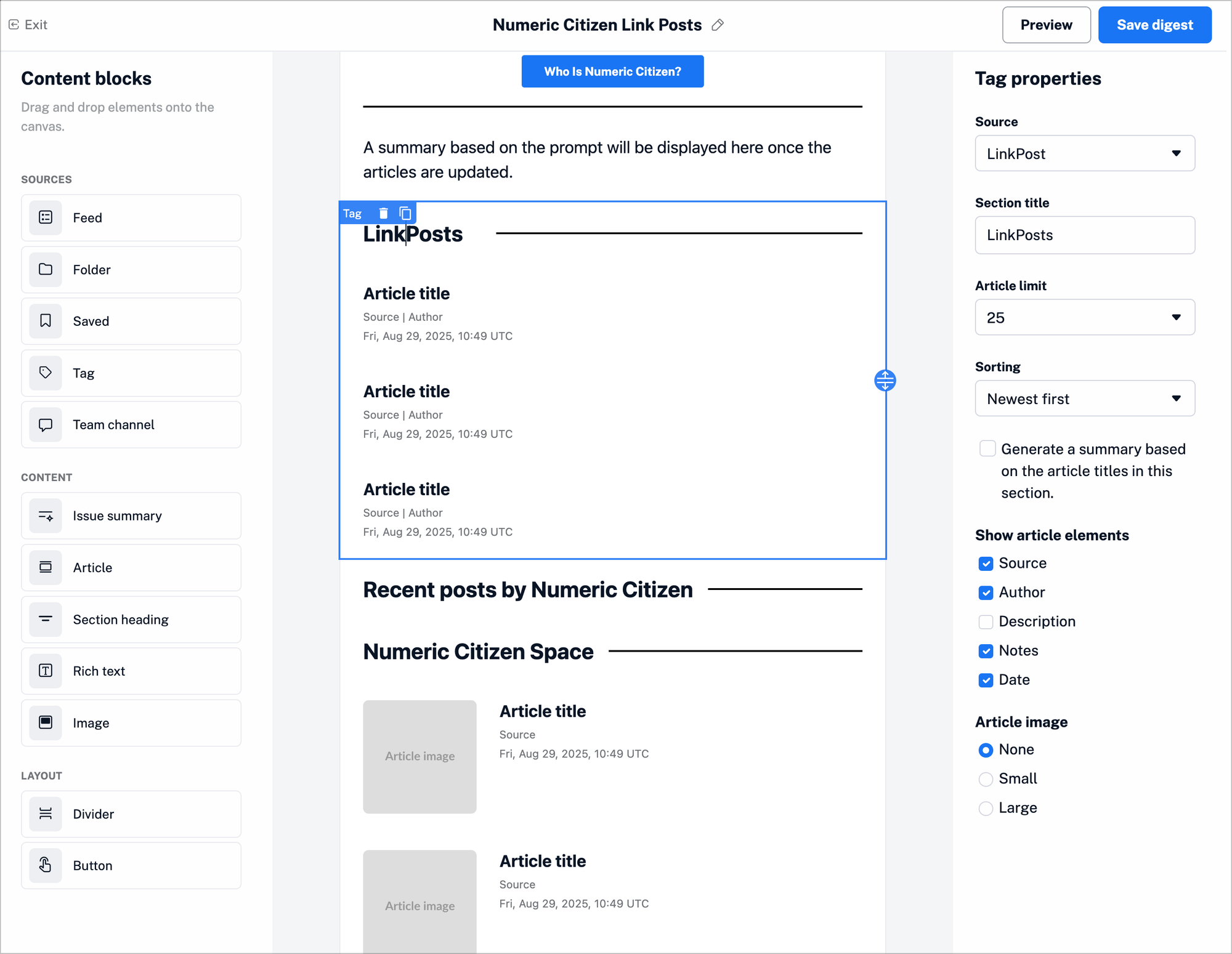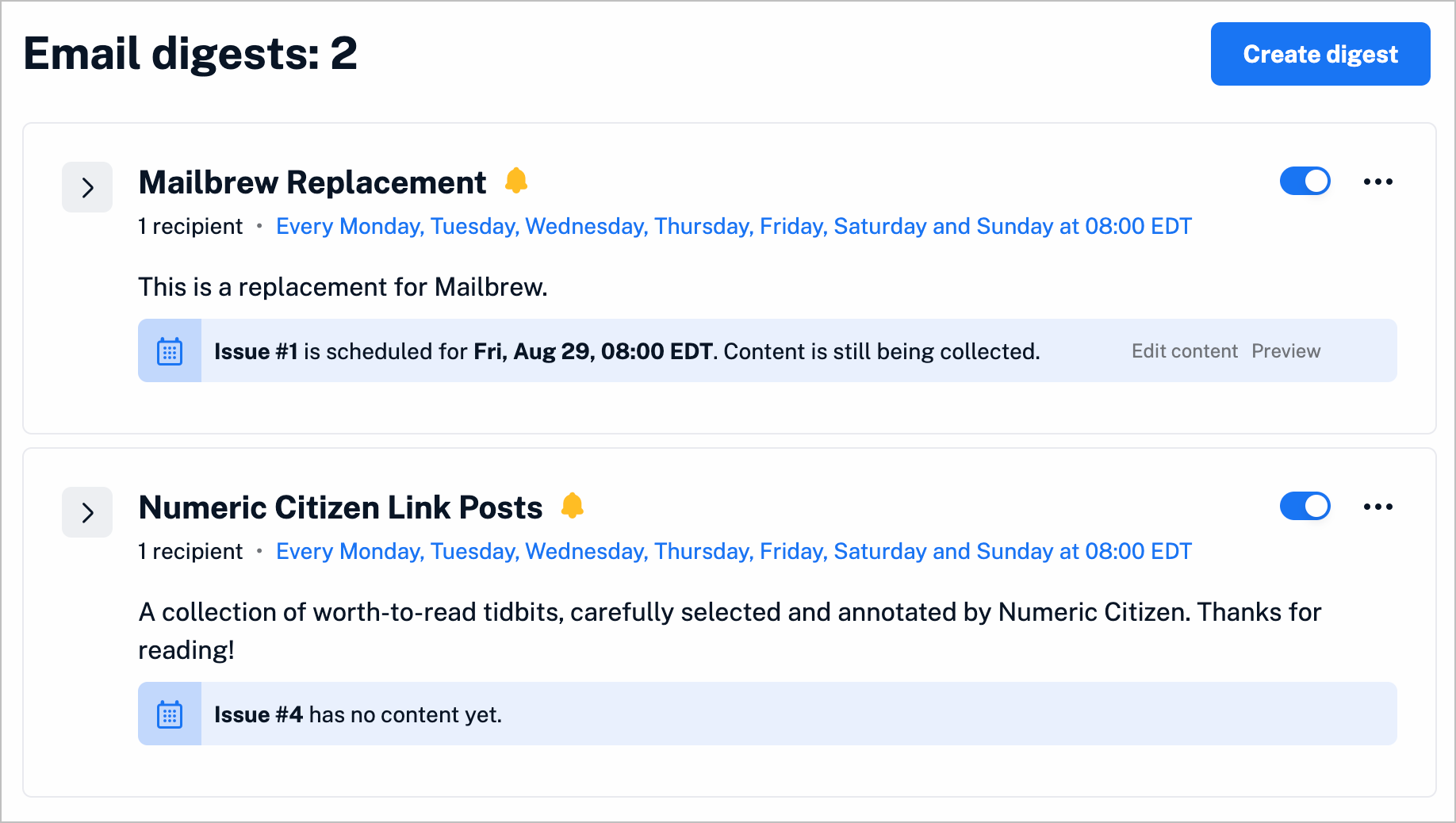Inoreader’s New Email Digest Feature: Promise and Limitations
I had a good experiment with Inoreader email digests. Here’s a recap and possible use cases.

Inoreader has long been a reliable choice for RSS power users like me. I wrote about it because it’s part of my reading workflow. Its new Email Digest feature attempts to extend the platform beyond feed reading by letting you package content into regular email updates. After experimenting with it, thinking that it could replace Mailbrew, I’ve gathered a few observations on what works, where it struggles, and how it is positioned compared to Mailbrew.
What It Brings to the Table
Put simply, Inoreader’s Email Digest allows you to build email summaries of RSS feeds. It’s nothing new, and Inoreader has had this capability for a long time.
The most notable addition is the option to add an AI-generated digest summary. Instead of receiving a raw list of articles, you can craft a custom prompt and let AI create an overview of the day’s or week’s content. This flexibility is powerful—whether you want a simple executive-style briefing or a more narrative recap.
Building digests themselves is straightforward with a special digest editor (see screenshot below). You can pull in any feed in your account or even bundle a group of feeds stored in a folder. For high-velocity feeds, the AI summary becomes especially useful; it condenses overwhelming flows into something you can actually act on. The ability to tailor the summary prompt makes this system surprisingly adaptable.

Tips for Getting the Best Out of It
While experimenting, I found that those tips will make the experience smoother:
- Stick to slow feeds with low-frequency updates; otherwise, your digests risk ballooning into inbox-clogging monsters.
- Be ruthless in feed selection. Too many inputs, and the digest loses its clarity.
- Think in terms of focused themes. A digest that gathers photos from top Glass photographers or curates posts from a handful of trusted bloggers works better than a broad “everything I follow” bundle. There is a limit of five digests in my current subscription trial. You can have more if you pay even more.
Where It Falls Short
The feature feels like a new iteration of something familiar, but the design is still limited in several key areas:
- No AI summaries for individual articles. The feature only works at the digest level or section level.
- Subscription friction. Others can’t directly subscribe to your digest; they must be invited manually, which feels tedious and clunky.
- No highlight support. Text highlights can’t be surfaced into digests, cutting off a potential use case for curated quotes.
- RSS dependency. While Mailbrew once connected to non-RSS sources like Twitter or email, Inoreader keeps you tied to feeds. This narrows the diversity of information you can pull in.
- Individual, not public. You can’t share your digest as a public newsletter with a URL; it’s designed for personal inbox delivery only.
- Poor fit for visual content. There’s no thumbnail-only view, so image-heavy feeds don’t translate well into digest form.
- Limited layout options. A denser, list-based layout would better handle text-heavy digests, but overall information density remains modest.
The AI Factor
The AI digest capability deserves special mention. It’s the feature that differentiates Inoreader from the older, more manual Mailbrew approach. The ability to tweak the prompt gives users fine control over tone and output style.
Want a corporate executive-style memo? You can write a prompt that frames it that way. Prefer a friendly, conversational recap? Adjust accordingly. In this sense, the digest becomes an editor you can shape.
Still, the lack of AI at the individual article level feels like a missed opportunity. Imagine opening your inbox and seeing one-paragraph AI summaries for each key article in your digest. That would reduce the need to click through everything while still surfacing value.
Comparing to Mailbrew’s Legacy

For those who used Mailbrew, comparisons are inevitable. Mailbrew positioned itself as a more open aggregator, pulling in sources beyond RSS—like newsletters, social feeds, and even custom integrations. That made it attractive for people who wanted a single pipeline for all kinds of digital content.
Inoreader, by contrast, is firmly rooted in RSS. This makes sense given its history, but it means digests risk becoming siloed. You’re essentially reformatting what you already follow in Inoreader, not extending into new territory. Where Mailbrew felt like a bridge between web services, Inoreader’s digests feel like a refinement of its core.
The trade-off is clear: more flexibility in AI summaries, less breadth in inputs.
Who Is It For?
The real question is audience. Right now, Email Digests feel best suited for:
- Personal knowledge management. If you want a private way to keep track of narrow topics, this could prove to be a good fit.
- Focused theme projects. For example, building a digest of photography blogs or tracking long-form writing on technology.
- Workflow aids. Professionals who want an inbox-friendly recap of industry news will enjoy email digests in Inoreader..
But if you’re looking to build a public audience, this isn’t it—at least not yet. There’s no shareable digest URL, no way to position yourself as a curator with a following.
Looking Ahead
The framework is there for something bigger. If Inoreader eventually opens up public-facing digests, adds highlight integration, and experiments with denser layouts, the feature could evolve into a strong alternative to dedicated newsletter tools.
Until then, it’s best thought of as an individual productivity enhancement, not a replacement for Mailbrew.
Final Thoughts
Inoreader’s Email Digest feature showcases flexibility in design, particularly with its AI prompt customization, but this comes with trade-offs in source diversity and some constraints around layout. Unlike Mailbrew, which is free, Inoreader charges an additional $7 a month to an existing Pro subscription. That’s a tough sell unless the feature becomes central to your workflow. I don’t think it’s my case.
For individual users, the tool may feel more like a nice experiment than an essential upgrade. In its current state, it’s best suited for tightly curated, personal digests rather than broader sharing or community-driven newsletters.



